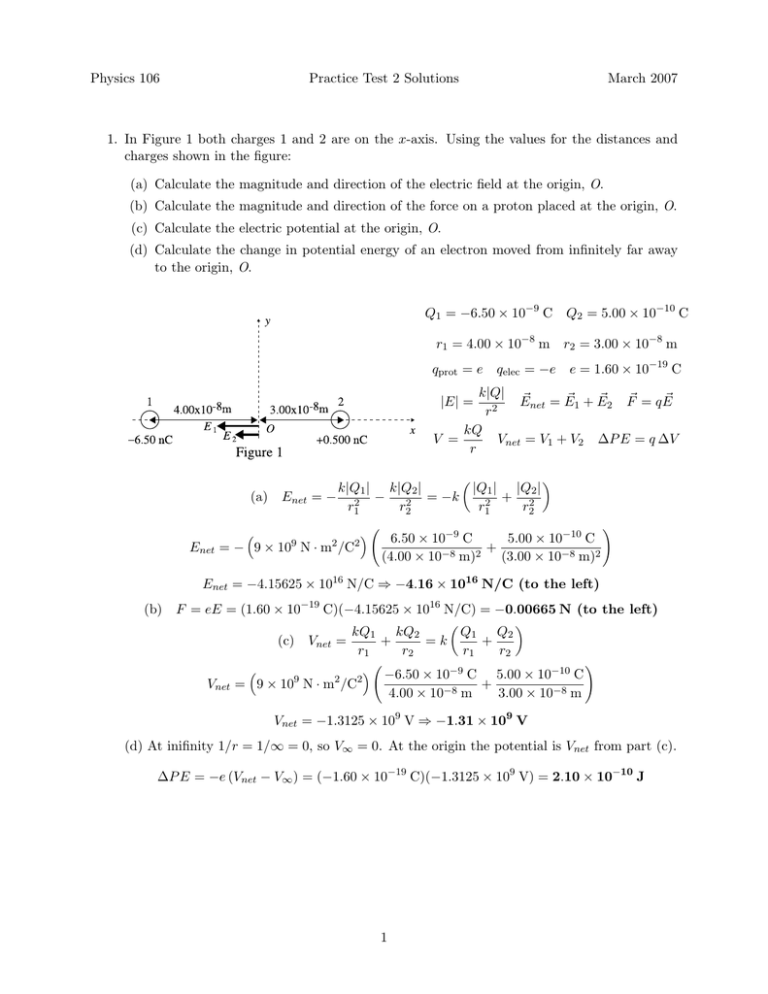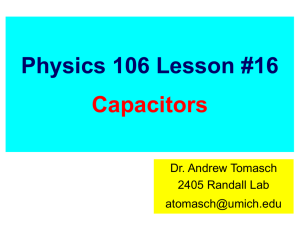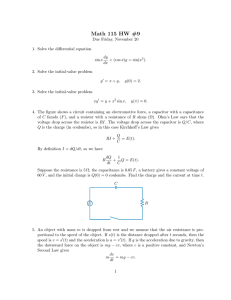Physics 106 Practice Test 2 Solutions March 2007 1. In Figure 1
advertisement

Physics 106 Practice Test 2 Solutions March 2007 1. In Figure 1 both charges 1 and 2 are on the x-axis. Using the values for the distances and charges shown in the figure: (a) Calculate the magnitude and direction of the electric field at the origin, O. (b) Calculate the magnitude and direction of the force on a proton placed at the origin, O. (c) Calculate the electric potential at the origin, O. (d) Calculate the change in potential energy of an electron moved from infinitely far away to the origin, O. Q1 = −6.50 × 10−9 C Q2 = 5.00 × 10−10 C r1 = 4.00 × 10−8 m r2 = 3.00 × 10−8 m qprot = e qelec = −e e = 1.60 × 10−19 C k|Q| ~ ~ ~1 + E ~ 2 F~ = q E Enet = E r2 kQ V = Vnet = V1 + V2 ∆P E = q ∆V r |E| = µ (a) Enet = − ³ 9 k|Q1 | k|Q2 | |Q1 | |Q2 | − = −k + 2 r12 r22 r12 r2 2 Enet = − 9 × 10 N · m /C 2 ´ Ã ¶ 6.50 × 10−9 C 5.00 × 10−10 C + (4.00 × 10−8 m)2 (3.00 × 10−8 m)2 ! Enet = −4.15625 × 1016 N/C ⇒ −4.16 × 1016 N/C (to the left) (b) F = eE = (1.60 × 10−19 C)(−4.15625 × 1016 N/C) = −0.00665 N (to the left) µ (c) Vnet = ³ Q1 Q2 kQ1 kQ2 + =k + r1 r2 r1 r2 Vnet = 9 × 109 N · m2 /C2 ´ Ã ¶ −6.50 × 10−9 C 5.00 × 10−10 C + 4.00 × 10−8 m 3.00 × 10−8 m ! Vnet = −1.3125 × 109 V ⇒ −1.31 × 109 V (d) At inifinity 1/r = 1/∞ = 0, so V∞ = 0. At the origin the potential is Vnet from part (c). ∆P E = −e (Vnet − V∞ ) = (−1.60 × 10−19 C)(−1.3125 × 109 V) = 2.10 × 10−10 J 1 2. Figure 2 shows a resistor network and a capacitor network. Using the values for resistance and capacitance shown in the figure: (a) Calculate the equivalent resistance of the resistor network. (b) Calculate the equivalent capacitance of the capacitor network. Principle: Series and parallel combinations of resistors and capacitors. (a) Find resistance R0 of the series combination of the 2.20 kΩ and 470 Ω resistors. Then find equivalent resistance Req of the parallel combination of the 1.50 kΩ and R0 resistors. R0 = 2200 Ω + 470 Ω = 2670 Ω 1 1 1 = + Req 2670 Ω 1500 Ω Req = 960.431 Ω ⇒ 960 Ω (b) Find capacitance C 0 of the series combination of the 10.0 µF and 8.00 µF capacitors. Then find equivalent capacitance Ceq of the parallel combination of the 15.0 µF and C 0 capacitors. 1 1 1 + = 0 C 10.0 µF 8.00 µF C 0 = 4.44444 µF Ceq = 15.0 µF + 4.44444 µF = 19.44444 µF ⇒ 19.4 µF 2 3. In Figure 3 the battery has an internal resistance r = 0.500 Ω and an emf, ε, of 1.54 V. Resistors R1 , R2 , and R3 are connected as shown. (Hint: You calculated the equivalent resistance in problem 2.) (a) What is the current, I, supplied by the battery? (b) What is the current (I1 , I2 , and I3 ) through each resistor? (c) What is the potential difference (V1 , V2 , and V3 ) across each resistor? (d) How much power PB is being supplied by the battery? (e) How much power (P1 , P2 , and P3 ) is being dissipated by each resistor? r = 0.500 Ω ε = 1.54 V R1 = 2200 Ω R2 = 470 Ω R3 = 1500 Ω R0 = 2670 Ω Req = 960.431 Ω Principle: Resistance and voltage. V = ε − Ir V = IR PB = εI PR = V I (a) The voltage supplied from the battery’s terminals is equal to the voltage drop across the resistor network. IReq = ε − Ir =⇒ I= ε Req + r = 1.54 V = 1.6026 mA ⇒ 1.60 mA 960.431 Ω + 0.500 Ω (b) The terminal voltage of the battery is: V = ε − Ir = IReq . This is the voltage across R3 and R0 , so it can be used to find the currents. V = IReq = (1.6026 × 10−3 A)(960.431 Ω) = 1.5392 V I3 = 1.5392 V V = = 1.0261 mA ⇒ 1.03 mA R3 1500 Ω I1 = I2 = V 1.5392 V = 0.57648 mA ⇒ 0.576 mA = 0 R 2670 Ω (c) Use Ohm’s Law V = IR. V1 = I1 R1 = (0.57648 × 10−3 A)(2200 Ω) = 1.2682 V ⇒ 1.27 V V2 = I2 R2 = (0.57648 × 10−3 A)(470 Ω) = 0.27094 V ⇒ 0.271 V V3 = V = 1.5392 V ⇒ 1.54 V (d) PB = εI = (1.54 V)(1.6026 × 10−3 A) = 2.468 × 10−3 W ⇒ 2.47 mW (e) P1 = V1 I1 = (1.2682 V)(0.57648 × 10−3 A) = 7.3109 × 10−4 W ⇒ 0.731 mW P2 = V2 I2 = (0.27094 V)(0.57648 × 10−3 A) = 1.5619 × 10−4 W ⇒ 0.156 mW P3 = V3 I3 = (1.5392 V)(1.0261 × 10−3 A) = 1.5793 × 10−3 W ⇒ 1.58 mW 3 4. In Figure 4 the battery provides an emf, ε, of 3.64 V and capacitors C1 , C2 , and C3 are connected as shown. (Hint: You calculated the equivalent capacitance in problem 2.) (a) What is the charge (Q1 , Q2 , and Q3 ) on each capacitor? (b) What is the voltage (V1 , V2 , and V3 ) across each capacitor? (c) How much energy (W1 , W2 , and W3 ) is stored in each capacitor? ε = 3.64 V C1 = 10.0 µF C2 = 15.0 µF C3 = 8.00 µF C 0 = 4.444 µF Ceq = 19.44 µF Principle: Capacitance and voltage. V = Q C W = 1 CV 2 2 (a) Q2 = V2 C2 = εC2 = (3.64 V)(15.0 µF) = 54.6 µC Q1 = Q3 = εC 0 = (3.64 V)(4.444 µF) = 16.176 µC ⇒ 16.2 µC (b) V1 = Q1 16.176 µC = = 1.6176 V = 1.62 V C1 10.0 µF V2 = ε = 3.64 V V3 = (c) W1 = 16.176 µC Q3 = = 2.022 V ⇒ 2.02 V C3 8.00 µF C1 V12 (10.0 µF)(1.6176 V)2 = = 13.083 µJ ⇒ 13.1 µJ 2 2 W2 = (15.0 µF)(3.64 V)2 C2 V22 = = 99.372 µJ ⇒ 99.4 µJ 2 2 W3 = C3 V32 (8.00 µF)(2.022 V)2 = = 16.353 µJ ⇒ 16.4 µJ 2 2 4 ε1 = 9.00 V ε2 = 4.50 V 5. For the circuit shown in Figure 5 find: (a) The current through each resistor. R1 = 5600 Ω R2 = 3300 Ω R3 = 1500 Ω (b) The voltage across each resistor. Principle: Kirchhoff’s Rules for junctions and loops. Junction B: I1 + I3 = I2 Junction E: I2 = I1 + I3 Loop ACDFA: −I1 R1 − ε2 + I3 R3 + ε1 = 0 Loop ABEFA: −I1 R1 − I2 R2 + ε1 = 0 Loop BCDEB: −ε2 + I3 R3 + I2 R2 = 0 (i): I2 = I1 + I3 (ii): 4.50 − 5600I1 + 1500I3 = 0 (iii): 9.00 − 5600I1 − 3300I2 = 0 Substitute (i) into (iii): (iv): 9.00 − 8900I1 − 3300I3 = 0 and solve for I3 : (v): I3 = 9.00 − 8900I1 3300 Substitute (v) into (ii) to find I1 : µ 4.50−5600I1 + ¶ 1500 (9.00 − 8900I1 ) = 8.5909−9645.45I1 = 0 3300 =⇒ I1 = 8.90668×10−4 A Substitute I1 into (v) to find I3 : I3 = 9.00 − (8900)(8.90668 × 10−4 ) = 3.25168 × 10−4 A 3300 Substitute I1 and I3 into (i) to find I2 : I2 = 8.90668 × 10−4 + 3.25168 × 10−4 = 1.21583 × 10−3 A Find voltages from Ohm’s Law V = IR: V1 = (8.90668 × 10−4 )(5600) = 4.9877 V V2 = (1.21583 × 10−3 )(3300) = 4.0122 V V3 = (3.25168 × 10−4 )(1500) = 0.48775 V Apply significant digits: I1 = 0.891 mA I2 = 1.22 mA I3 = 0.325 mA V1 = 4.99 V V2 = 4.01 V V3 = 0.488 V 5





